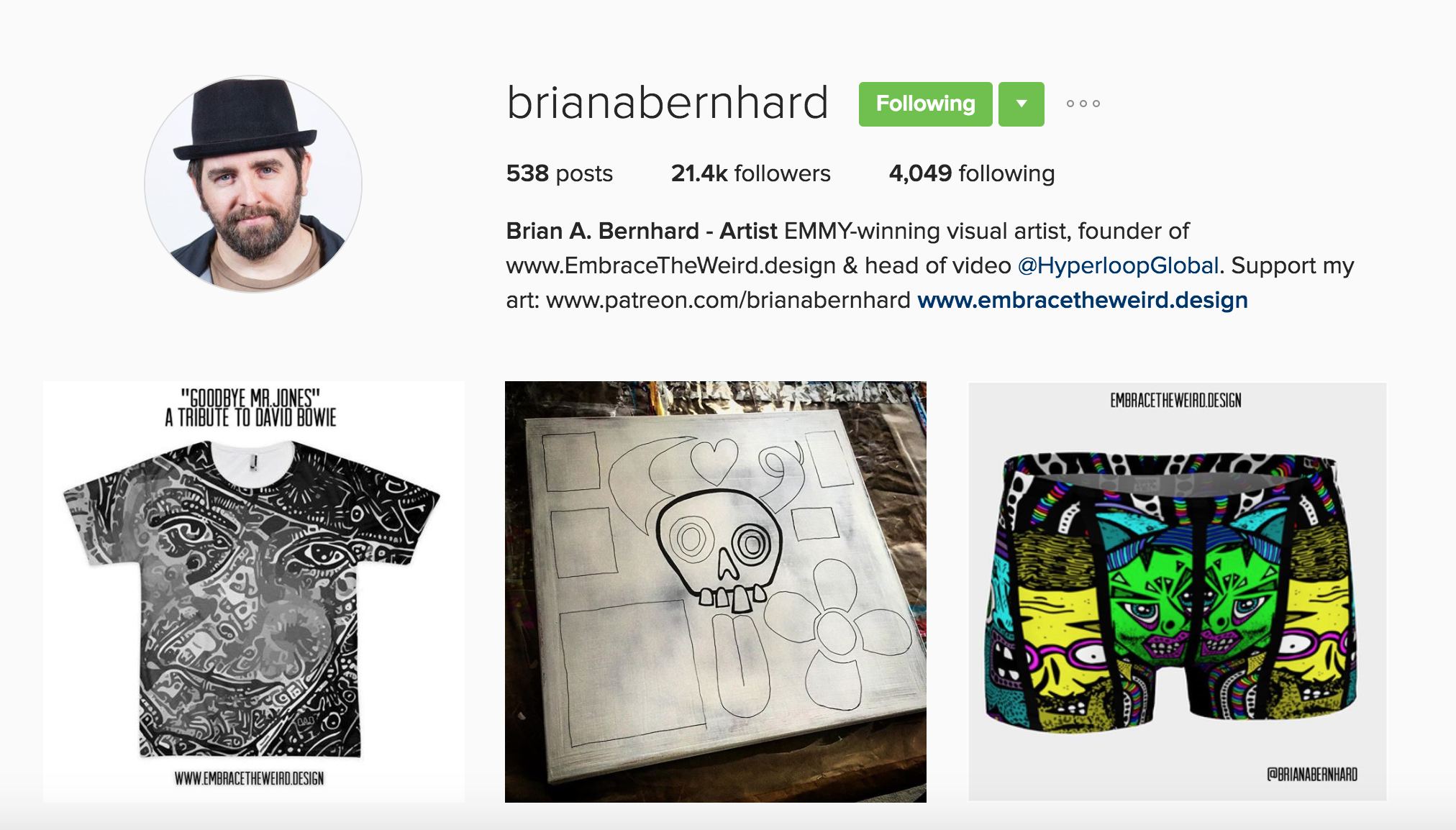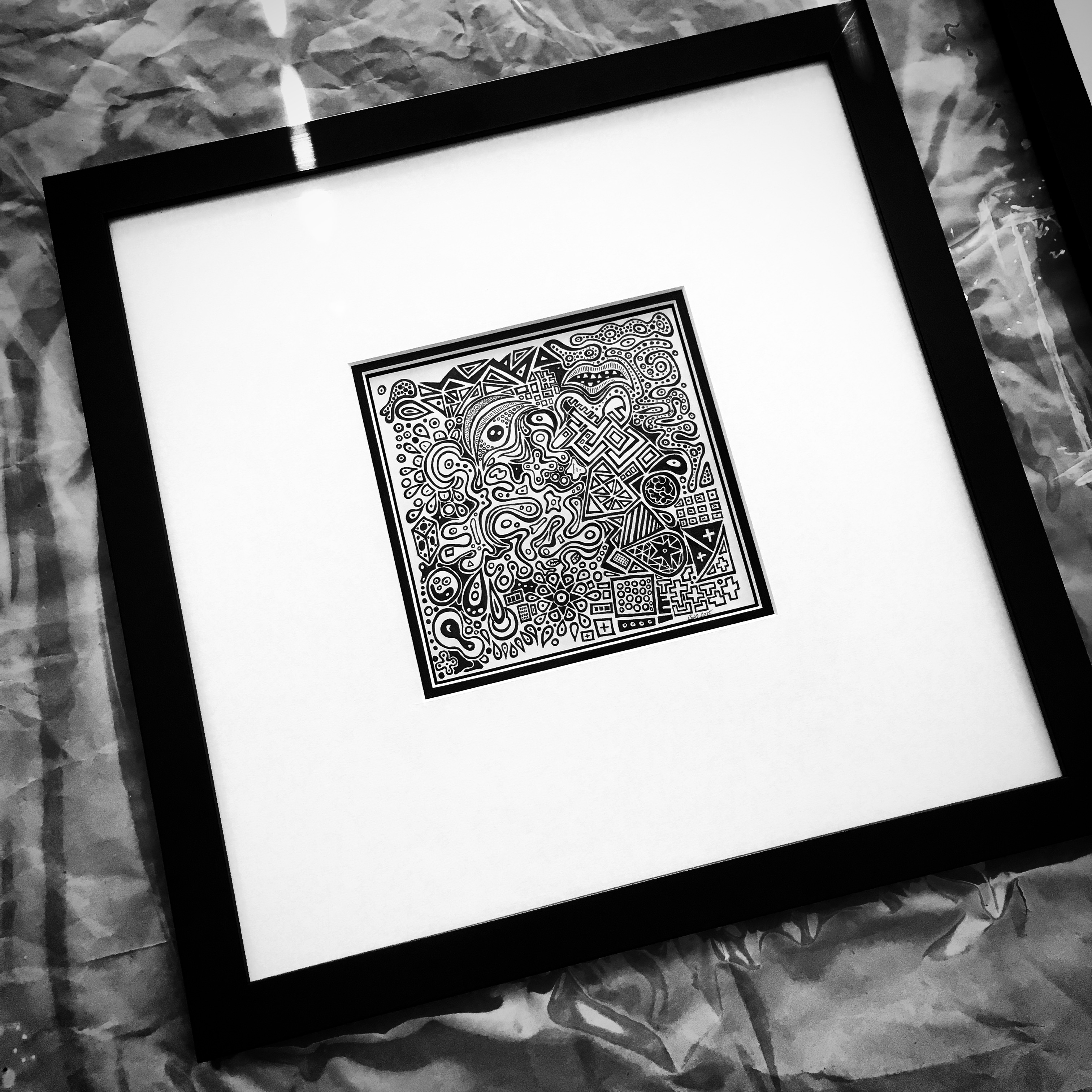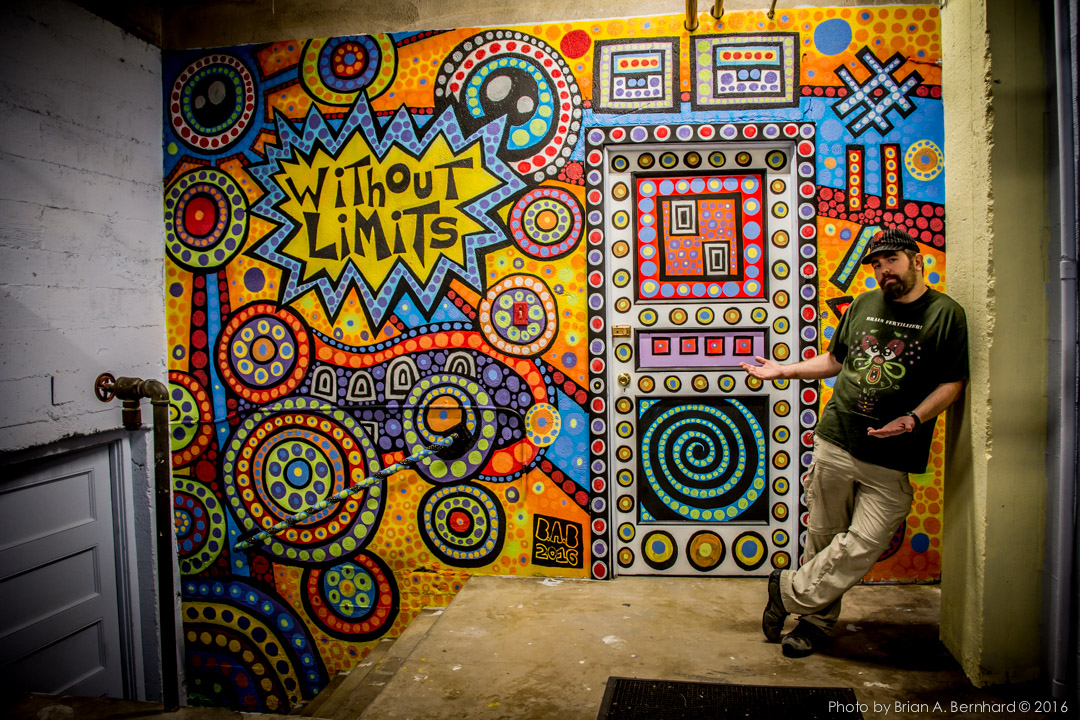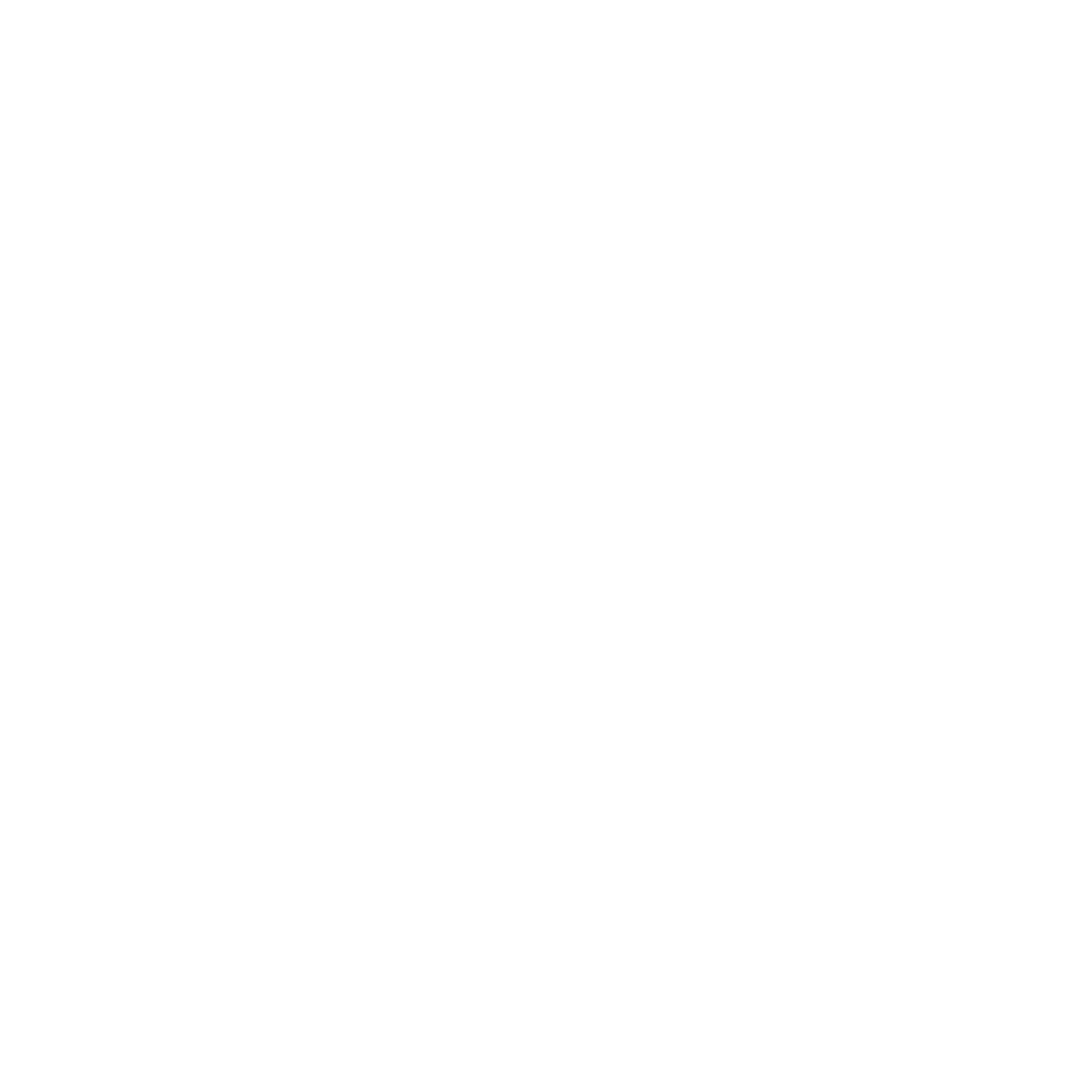Pictured: Bernhard, Brian A. Without Limits Mural. A variety of paint media on concrete wall, 11’ X 15′.
It started with a tweet—him to me, me to him? Something in between? Who knows!—and ended with this: An exchange of ideas by two people who’ve never met before. But sometimes you just connect with someone across the strange expanse of Internet and don’t know why, and it’s a kind of kindred-spirit connection that while tenuous in its real-life existence, goes far beyond the retina-display surface of your laptop screen; the whole thing’s actually much stronger than you think.
Such was the case with Brian A. Bernhard, digital storyteller, visual mastermind and dexterous font-maker whose artistic mission is for us not to run from but to the weirdest places inside us all. Embrace the esoteric eccentricities, his art in unspoken prose and frenetic brushstrokes might explain, because it’s the curious and not the common that makes the world twist in the most extraordinary of ways.

Brian A. Bernhard, EMMY-winning visual artist, founder of Embrace The Weird and head of video at Hyperloop Transportation Technologies.
MELISSA: As you say on your website, “I’m a maker of things, delightfully twisted and sarcastically strange things … I call these things art.” When did you first realize you had a passion to create this kind of uniquely weird and wondrous art?
BRIAN: I have been creating things that may have been considered art for as long as I can remember. Back in my elementary school days, I kept a sketchbook and I would draw weird stuff during my morning commute on the big yellow school bus. For some unexplainable reason, kids on the bus started asking to buy my drawings. I was selling my sketches for somewhere between a quarter and a whole dollar! I was rolling in chocolate milk money! However, when the school bully started buying my drawings instead of sucker punching people, I knew I was onto something interesting.

Bernhard, Brian A. Chaos Flower. Acrylic on canvas, 16″ x 16″. Price upon request.
Your Embrace The Weird lifestyle brand is targeted at self-professed (and maybe secret) weirdos. Why are your products for the outliers, the misfits, the can’t-contain-’em-in-a-box types?
One thing I’ve learned in all my years is that absolutely everyone—no matter how much in denial they may be—is full of secret weirdo-sauce! Allowing your inner weirdo to escape the confines of social normalcy is really equivalent to emotional and creative freedom. I see my artwork and products as kind of a gateway drug, a stepping stone to inspiring one’s true creative potential. When you feel comfortable in your skin, as a human, and you allow yourself to be who you are, your mind-clutter is cleared away and your senses can be open and ready to truly experience the amazing things that life has to offer.
Also, I’ve never really identified with any lifestyle brands or fashion trends and I began to wonder if it was me or if I just perceived all of my other options to be boring and lifeless. So, I decided to do something about it … and started designing stuff I wanted to wear, stuff that spoke to me and things that I could identify with; I decided that I finally wanted to allow myself the creative freedom to embrace the weird.

Bernhard, Brian A. Alien Sex Toy Skate Deck. Canadian Maple from sustainable forests, 8″ wide skateboard deck. Price upon request.
Embrace The Weird, as it’s described online, is meant to help people “embrace their inner weirdos.” I love that mission because I think underneath the polished exterior and polite rhetoric, we’re all totally, completely weird. How does your art bring that universal weirdness to life?
You are correct … everyone is a weirdo. The more people try to fit themselves into the “normal” box the more bizarre and strange they become. I think most people cause themselves a great deal of stress by constantly suppressing who they really are. My mission is to enable folks to dance outside the “normal” box from time to time and possibly discover how they can embrace their inner weirdo!

Bernhard, Brian A. Love Explosion. Ink on paper, 10″ x 10″. Price upon request.
You’ve got one seriously impressive resume: You’re an EMMY, TELLY award-winning visual artist, digital media strategist, producer, director, designer, illustrator, editor … the list goes on. And you’ve worked on projects for studios as big as 20th Century FOX, ABC and more. How did you get your start as an artist and you did you ever think you’d find such amazing success?
Well, I think an artist starts when they decide to make art. I guess back when I was selling drawings to kids on the big yellow school bus, I would have been considered an entrepreneurial professional artist. I mean the general consensus is that you become a professional when people pay you for your art.
Of all of the credits I have, there are only a few of them where I would accept the title of professional artist/creator. Most of my credits and awards have come from creative service jobs, where I was helping to make/create/facilitate someone else’s ideas. I think there is a difference between being an artist and working in the creative services.
The NYC-based TV series I created back in 2005 called “ART or something like it!” was one of the projects I did that balanced on the line between creative service and art. It was a docu-series I created, produced and edited featuring amazing artists from all over the tri-state area. I treated each episode like a unique piece of video art; I interviewed people who inspired me and I created a public service forum that gave a voice to undiscovered artistic visionaries. The series was eventually nominated for an EMMY.

Bernhard, Brian A. The Starship. UV ink on sustainable Canadian forest wood, 12″ x 12″. Price upon request.
Any advice for someone just starting out in the art/creative world who might find the idea of being an artist scary, daunting and maybe even a little bit impossible to achieve?
In this day and age, making a living as an artist is both more difficult and easier than ever before. WTF? How can it be both? This guy must be off his rocker! Well wait, let me explain. It’s all because of technology and the internet. On one side of the tech-web, artwork and creative intellectual property have been completely devalued, creative service jobs that once paid decent money now pay below minimum wage. Freelance creatives struggle from gig to gig and from pitch to pitch, attempting to underbid the next creative hustler and they all end up working for almost nothing. It’s the downward spiral art hustle to burnout land that we know all too well. Musicians cannot make a living from music because most listeners would rather download the MP3s for free and visual art fans seem to think it’s socially acceptable to download artwork, using it on their social media or printing it out while never contributing to the original creator’s bottom line. The life of an artist stuck in the ’90s is tough to navigate in the 2000s; the traditional modes of monetizing art no longer work, so many creators have given up and condemned their art career to hobby town.
However on the brighter side of the tech-web, an artist who has embraced their inner entrepreneur as well as their inner weirdo can manifest some magical things. The tech world may have devalued the previous models of making money from art but it has given birth to some truly amazing ways of making a creative living. From Patreon to Shopify and everything in between, we artists now have the ability to connect with more eyeballs than ever before.
Use social media like a rock star. Be a broadcaster, build your audience, build your brand, become an industry unto yourself. The tools for unbridled success are out there if you are willing to build something worthwhile with your creative flow. The days of passively sitting on your hands waiting for some eccentric art collector to discover you are over. I am not really even convinced that was ever actually a thing, it may have been at one time but it was still akin to winning the lottery or finding a needle in a haystack.
 When working with some of the big-name brands and studios, do you find it’s sometimes harder to maintain your creative edge in the face of corporate compliance, legal restrictions and all the other things that go on at big companies? How do you overcome these hurdles to creativity and produce work that’s original and fresh?
When working with some of the big-name brands and studios, do you find it’s sometimes harder to maintain your creative edge in the face of corporate compliance, legal restrictions and all the other things that go on at big companies? How do you overcome these hurdles to creativity and produce work that’s original and fresh?
When working with big brands, studios and other companies, you better be excited about what THEY are doing, and you better be willing to give all your creative mojo to designing solutions for whatever you are getting paid to create because you are a work for hire. It’s not ever art; you are designing creative solutions.
Designing creative solutions can be fun, if there is a mutual trust between the creative and the company. Good companies allow the creatives to do what they do best, and they generally get fresh and unique solutions. Bad companies tend to micromanage, derail and belittle the creative teams every step of the way, and the results never come to a satisfactory end for either party.
My solution to this issue was to create my own company, one where I am free to allow my creative to flow in whatever direction the wind blows. I am now the corporate and the creative and I think, so far, this business relationship has produced positive results.

Bernhard, Brian A. Worried Tiki. Ink on paper, 10″ x 10″. Price upon request.
Who are your artistic influences and what about their work inspires your own?
Inspiration comes in all shapes and sizes. My creative language has been informed by so many I could not possibly list them all here, but some highlights would be Edward Gorey, David Lynch, The Residents, Primus, Devo, Bill Viola, Tony Oursler, Philip Guston, Roy Lichtenstein, Bill Plympton and many, many more. Currently, I have been studying and learning the creative process of successful business people, so that I can apply it to my art practice. I have been studying brands like tokidoki, Kidrobot and Obey and reading books like Superbosses: How Exceptional Leaders Master the Flow of Talent and Rich Dad, Poor Dad. I have also been seeking out mentors and folks who have already done what I am doing, so I have a team of people I can go to for advice.
Who’s one artist/designer/creator/mover/shaker/boundary-pusher today who totally motivates you to make your art even wilder and weirder?
That would have to be Banksy. He has been able to create a movement in the art world through the building of an amazing narrative and mythology. His unique perspective has transcended into the mainstream. He pushes the envelop and even trolls entire cities and corporate giants. His work is meaningful, inspiring and makes me want to create something influential that matters, something that might be remembered for years to come.
http://www.instagram.com/p/BObycgTjQlm/?taken-by=brianabernhard
You’re working on a custom font. Talk to me about that process, why you decided to make your own font and in an ideal world, what you’d like to see your lettering displayed on … A billboard over Sunset Boulevard? A Midtown Manhattan bus? A Starbucks cup? A small bookstore in Middle-Of-Nowhere, Montana?
I wanted to make a custom font for a variety of reasons. I often add text to my artwork and branding—I am not a huge fan of any front—so I normally try to draw all the text I use in my graphics by hand, which has proven to be a very time consuming challenge. By creating my own font, I can generate text in my graphics and branding at a much more efficient speed, thus allowing me to create more unique products while keeping a consistent and totally original look and feel.
The process of making the font was a little less straightforward. First I drew the font in my sketchbook and inked all the letters of the alphabet in both sets, capital letters and lowercase, including all the symbols I thought that I could use. I then scanned the drawings into photoshop, where I cleaned them up a bit and vectorized the characters in Illustrator. After which I looked around for font-making software, so I could convert the graphics into a typeface but the good stuff is very expensive. So I found a guy on fiverr who converts handwritten text into truetype fonts. He gave me a size and character template to plug all my graphics into and a few days later I had a usable font.

Bernhard, Brian A. Observation Flow. Ink on paper in a hardwood frame with museum-grade glass, 18″ x 18″. Price available upon request.
Your definition of art is masterful: “Art is weird, it’s subjective, it’s lonely, it’s powerful, it’s a struggle, it’s beautiful, it’s ugly, it’s everything, it’s nothing, it’s a community and sometimes it changes the world.” The beautiful/ugly, everything/nothing … there really is such an obvious dichotomy to art that’s hard to explain but easy to feel. How do you think, in this sense of artistic elusiveness, your art helps in some way to change the world?
Well, I don’t know if my work has actually changed the world in any meaningful way yet—I aspire to do so—I can only keep moving forward. However, I am proud to say that my work has connected with a few people out there and I think that in some small way, the work has changed their lives. Right now, I am truly excited by how my products have connected with a whole new audience, an audience that never connected to my artwork before I launched “Embrace the Weird”.
I have been making art for a really long time. I have been posting said art to social media for a very long time but it was not until I began to put my art onto tangibly accessible products that the unexpected people began to take notice. As an experiment, I designed some leggings and the strangest thing happened: When I posted them on Facebook, people who have not commented on or liked any fine art I have posted in years began to comment, like and share the work. People began to tag their friends, they started to buy the leggings and brag online about how amazing they were … then they went deeper into my weird rabbit hole. The leggings were the hook but now they wanted to buy other stuff and some even wanted to collect my original art works!
The leggings acted like a gateway drug for people to enter my art world. It was like I tapped into something that they were comfortable with and it allowed them to see my art for the first time in a new way. It was as if something opened up from within and finally gave them permission to allow their inner weirdo to come out and play.
[Editor’s Note: Brian’s art is currently being shown at The Artists’ Studio Gallery on the promenade in Palos Verdes. He also has an upcoming solo art exhibition in June at the Palos Verdes Library District main branch art gallery.]



The weirdo in me is awakened! Inspiring interview. Thanks for the reminder.